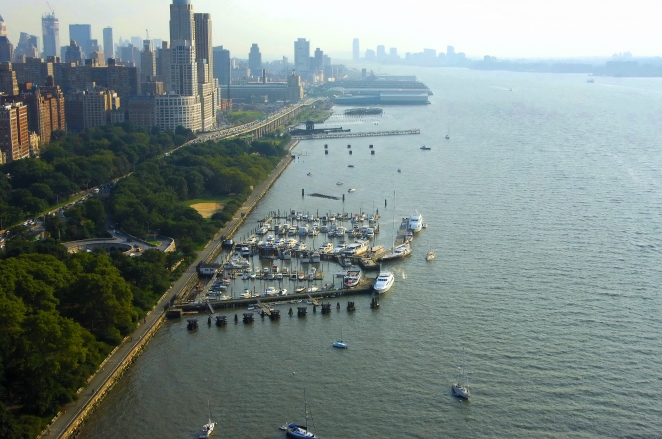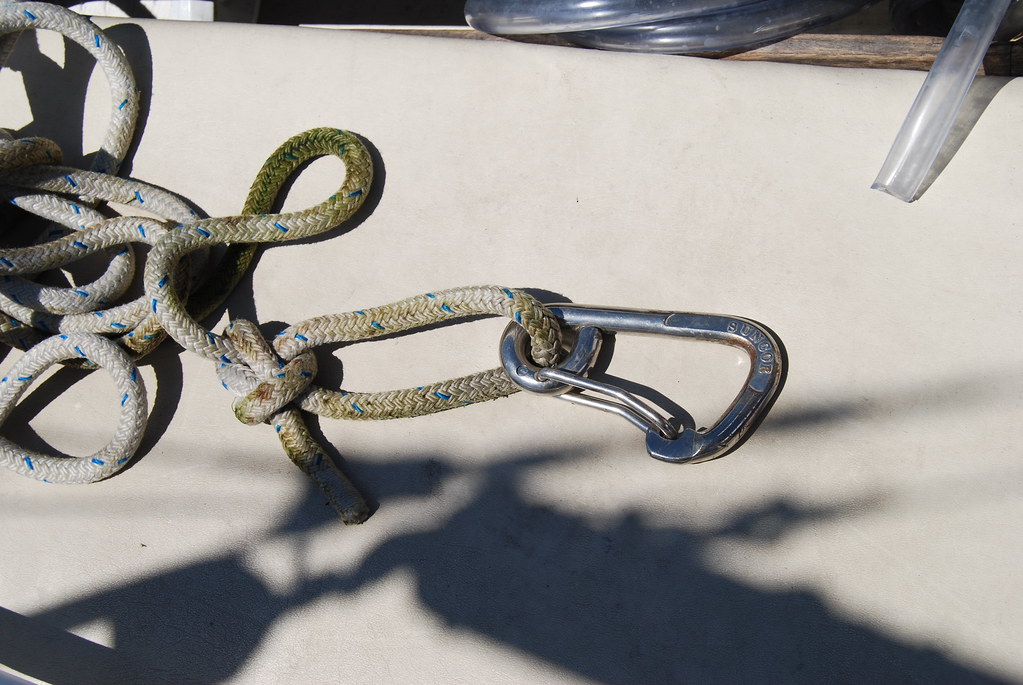That's the 79th Street boat basin, above. But the boats you see there inside the breakwater belong to the hereditary aristocracy. Apply for a slip today, and your great-grandchildren might possibly get it.
No, οἱ πολλοί, like me, get moorings, outside the cozy little enclosure you see, in a field extending uptown -- i.e. toward the bottom of the picture. You can see a few boats in part of the field.
It's a pretty convenient place to keep your boat if you live on the Upper West Side, but otherwise has little to recommend it. The current -- especially the ebb current -- is incredibly fierce, and it's completely unprotected from swell and chop and wakes from commercial shipping and big displacement-hull motor yachts, so your boat gets knocked around a lot. Your mooring lines chafe and sometimes part. Moorings have been known to drag. Stuff comes floating down the river at five or six knots -- logs, big pieces of timber, that sort of thing -- and bangs into your hull. A snug harbor it ain't.
Among other things, the wicked current makes it a tricky business to pick up your mooring. You have to creep up-current toward the mooring, as if you were stalking some skittish animal with a sensitive nose, grab the mooring lines -- which are probably tangled around the anchor chain under the buoy -- get them aboard and secured to a cleat, while simultaneously throttling down and shifting the motor into neutral. If you're single-handing this requires you to have three arms and be in two places at once -- the cockpit to deal with the motor and steer, and the bow to grab the mooring lines. Imaginative readers can probably visualize the scrambling, the swearing, the confusion, the Keystone Kops comedy of it all.
(Did I mention that it's a crowded mooring field, with other boats nearby to collide with if anything goes wrong; and that there's always a nasty crosswind?)
But help is at hand:
Last year I happened to see the ingenious device shown above in the Bosun Supplies catalogue, a favorite compendium of boat-geek gadget-porn. (You can click on the image to see more detail.) It's a hook, with a spring-loaded shackle that closes it. The shackle is held open by a clip attached to your boat pole; that's the state shown above. You get the hook around something -- an eye, a line -- and give a tug. The hook is pulled out of the clip and the shackle closes, as shown below:
Aha, thinks I, I can run a line back from the bow to the cockpit, attach this clever little widget to the line, bring the boat up alongside the mooring buoy, get the hook around the ring on top of the buoy (the one the mooring lines are attached to), and be fast to the mooring in one quick dart of the boat pole. Now I can throttle down and shift into neutral and take more than a millisecond doing it, if necessary, knowing that I won't drift any farther back down-current than the length of the line attached to my clever self-closing hook, which is to say something less than the length of the hull. And in fact without too much scrambling I can get myself up to the bow and pull the boat along the line up to the buoy and get the real mooring lines aboard before I've even drifted that far.
That was the idea, anyway, and it worked fine -- up to a point.
My mooring this year is number NE-18, which is closer to the boat basin and the dinghy dock than last year's was -- it's at about the latitude of 90th Street, or thereabouts, a half-mile or so from the dinghy dock. And it's in the row of moorings closest to shore -- maybe fifty feet -- and in fairly shallow water (fifteen feet). I was kinda pleased by this, since I figured the current and the chop might not be so bad closer to shore.
But of course, on the other hand, you're closer to shore. And this is what the shore looks like:

Can you see that the shore is lined with big rugged boulders, laid down to keep the landfill in place back when Robert Moses extended Riverside Park, and built the west side highway?
Perhaps you can see where this is going. I'll spare you the blow-by-blow. I crept up to my mooring, darted my boat pole at the buoy, heard the satisfying click as the hook escaped from the clip and the shackle snapped shut. I calmly throttled down, shifted the motor into neutral, sauntered toward the bow -- and then heard the unspeakably horrible noise of my iron keel grating against one of those Robert Moses boulders. It's a noise I hope you never hear, and I'll awaken in a cold sweat for years to come, hearing it in my dreams.
Here's what had happened:
The galvanized iron eye on top of the buoy, which I had hooked onto, was so thick that the clever spring-loaded shackle couldn't close all the way over it and secure the hook. I really ought to have a picture of this situation, because it may be hard to visualize; but alas I don't. At any rate the hook dropped off the buoy and without knowing it I was adrift, unsecured to anything, in maybe three knots of downstream current and five knots of west wind, which pushed the poor ill-managed and incompetently-captained Scapegrace right onto the rocks, in less time than I would have believed possible.
The next thirty seconds or so are a terrible gray fog in my memory, lit by a few lurid flashes:
- Me trying to fend several tons of wind-driven boat off a troll's jaw of snaggletoothed rocks with a flimsy aluminum boat pole. Dream on.
- A cyclist, along the riverfront path, maybe four or five feet from my face with its pale rictus of fear and horror, looking down at me and saying "Oh whoa ho ho" or "Woo hoo hoo" or something similar. I'm glad to say he was a very dorky middle-aged West Side cyclist, wearing a helmet, and difficult as it may be to believe, I was reminded even in these extreme circumstances of Dr Johnson's famous letter to Lord Chesterfield(*).
- Feeling the boat rock a little with the swell -- not hard aground, then! -- and scampering back to the cockpit and shifting the motor into forward and gunning the throttle and praying, no-shit praying that we could horse her back into deeper water.
I don't think the hull hit the rocks. I think it was just the iron keel. There was no water in the bilge, and the keel bolts still seemed as firmly seated and as well sealed as ever, when I took a look after my pulse rate came back to a standard deviation or two over normal. But the only way I'll really know what happened is to put on the mask and fins and plunge -- facilis descensus Averno -- into the toxic soup of the Hudson and take a look. Which I will do, as soon as I've had a tetanus shot.
Meanwhile I feel, dear reader -- and pardon my language -- like shit. I feel incompetent, and foolish, and culpable.
Back in the day the Royal Navy used to court-martial any captain whose ship was wrecked. I see the point. My ship wasn't wrecked but I still deserve a court martial, and if I had one, the way I feel right now, I would plead guilty and insist on the death penalty.
-----------------
(*) "Is not a patron, my lord, one who looks with unconcern on a man struggling for life in the water, and when he has reached ground, encumbers him with help?"



At least the current always flows past your mooring in the same direction. This is not always the case. Back in '69-'70 we anchored Asheville (PG-84) in a tidal river, the Son Cua Lon. The current was swift most of the time but stopped completely with the tidal shift. Almost every night when the current reversed, the Asheville began to float down the river merrily dragging its anchor. Nothing ever scared me as much as strolling out to the stern with a flashlight and seeing the bank about 40 feet away and closing fast! A moonless night during the midwatch with practically the entire crew asleep.
ReplyDeleteIf you google map search "Năm Căn, Cà Mau, Vietnam" you will get a nice satellite image of the river. It is the blue line running through the label "Khanh Binh". You can see why the tidal shift kept us on our toes.
The solution for us: a bigger anchor, something from a navy salvage yard about 6-8 times as heavy as our standard issue anchor. We used to transfer this behemoth to the gunboat that relieved us and get it back when our next turn arrived.
http://brownwater-navy.com/vietnam/Seafloat.htm has a mislabeled picture of our river (Cau for Cua).
I enjoyed your blog, Nasty Mike. See you around the SMBIVA comments.
Flak
Hey Flak --
ReplyDeleteActually the current *does* reverse in my part of the Hudson, though the ebb is longer and stronger than the flood, of course. Particularly if it's been raining up in the Adirondacks, as it often does.
The current reversal is how the mooring pennants get wrapped around each other and fouled on the mooring chain.
Dragging an anchor is a nasty experience. It's happened to me once. Makes me feel a bit better to hear that it happens to the Navy, too.